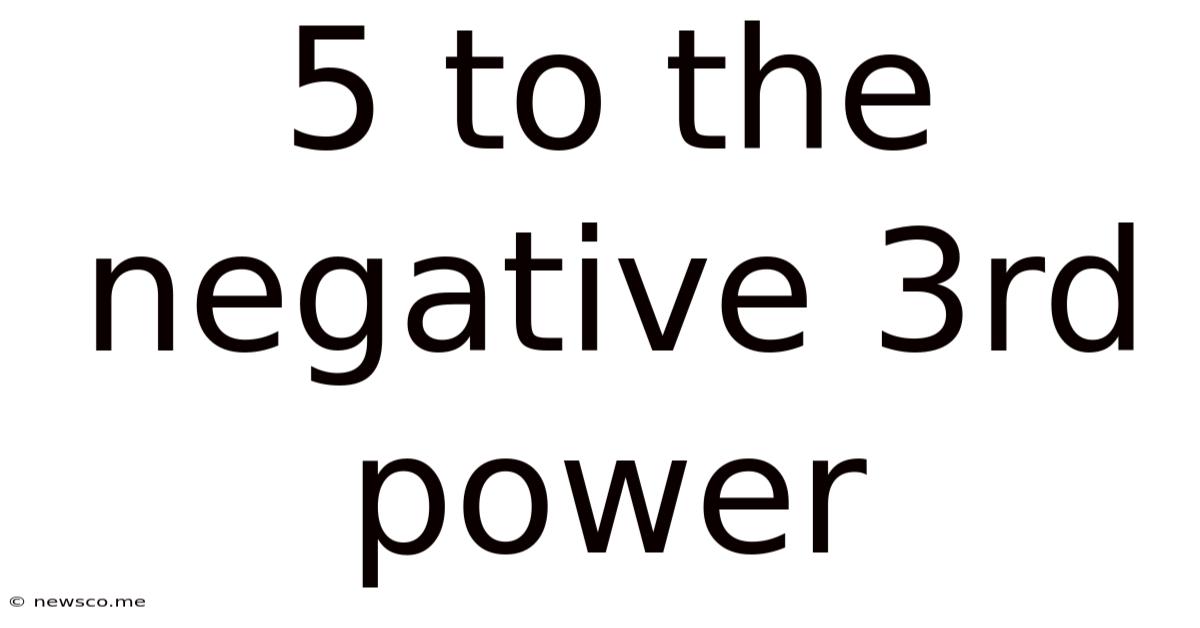5 To The Negative 3rd Power
News Co
May 08, 2025 · 5 min read

Table of Contents
5 to the Negative 3rd Power: A Comprehensive Exploration
Understanding exponents, especially negative ones, can be a stumbling block for many students and even adults grappling with mathematical concepts. This comprehensive guide delves into the meaning and calculation of 5 to the negative 3rd power (5⁻³), exploring its underlying principles and providing practical examples to solidify your understanding. We'll move beyond simple calculation and explore the broader context of negative exponents within the larger framework of exponential notation and its applications in various fields.
Understanding Exponents: A Quick Refresher
Before tackling negative exponents, let's refresh our understanding of what exponents represent. An exponent, also known as a power or index, indicates how many times a base number is multiplied by itself. For instance:
- 5² (5 to the power of 2 or 5 squared) means 5 x 5 = 25
- 5³ (5 to the power of 3 or 5 cubed) means 5 x 5 x 5 = 125
- 5⁴ (5 to the power of 4) means 5 x 5 x 5 x 5 = 625
The base number is the number being multiplied, and the exponent tells us how many times to perform the multiplication.
Deciphering Negative Exponents
Negative exponents introduce a crucial twist: they represent the reciprocal of the positive exponent. In simpler terms, they indicate division instead of multiplication. The rule is:
a⁻ⁿ = 1/aⁿ
This means that any base number raised to a negative exponent is equivalent to 1 divided by that base number raised to the positive value of the exponent.
Calculating 5 to the Negative 3rd Power (5⁻³)
Applying this rule to our problem, 5⁻³, we get:
5⁻³ = 1/5³
Now, we calculate 5³ (5 to the power of 3):
5³ = 5 x 5 x 5 = 125
Therefore:
5⁻³ = 1/125
This is the final answer. 5 to the negative 3rd power is equal to one one-hundred-and-twenty-fifth (1/125). This can also be expressed as a decimal: 0.008.
Practical Applications of Negative Exponents
While this might seem like a purely abstract mathematical concept, negative exponents have significant practical applications across numerous fields:
1. Scientific Notation
Scientific notation is a crucial tool in science and engineering for expressing very large or very small numbers concisely. Negative exponents are essential for representing extremely small numbers. For example, the diameter of an atom might be expressed as 1 x 10⁻¹⁰ meters.
2. Compound Interest and Exponential Decay
In finance, negative exponents can describe situations where a value decreases exponentially, such as the decay of an investment's value or the depreciation of an asset over time. Formulas for compound interest often utilize negative exponents to calculate the present value of a future amount.
3. Physics and Engineering
Negative exponents frequently appear in physics and engineering formulas describing phenomena like radioactive decay (half-life calculations), light intensity, and electromagnetic fields.
4. Computer Science
In computer science, particularly in areas like data compression and algorithm analysis, negative exponents are used in the context of exponential functions and logarithmic scales.
Expanding Our Understanding: Properties of Exponents
To fully grasp the concept of 5⁻³, it's helpful to understand the fundamental properties of exponents, including:
- Product of Powers: When multiplying two powers with the same base, you add their exponents: aᵐ x aⁿ = aᵐ⁺ⁿ
- Quotient of Powers: When dividing two powers with the same base, you subtract their exponents: aᵐ / aⁿ = aᵐ⁻ⁿ
- Power of a Power: When raising a power to another power, you multiply the exponents: (aᵐ)ⁿ = aᵐⁿ
- Power of a Product: When raising a product to a power, you raise each factor to that power: (ab)ⁿ = aⁿbⁿ
- Power of a Quotient: When raising a quotient to a power, you raise both the numerator and the denominator to that power: (a/b)ⁿ = aⁿ/bⁿ
These properties, along with the rule for negative exponents, allow you to manipulate and simplify expressions involving exponents efficiently. For example, you can use these properties to rewrite 5⁻³ in different but equivalent forms.
Beyond 5⁻³: Exploring Other Negative Exponents
Understanding 5⁻³ lays the foundation for comprehending other negative exponents. Let’s consider some examples:
- 2⁻⁴: This is equivalent to 1/2⁴ = 1/16 = 0.0625
- 10⁻²: This is equivalent to 1/10² = 1/100 = 0.01
- (1/3)⁻²: This might seem trickier, but remember the reciprocal rule. It simplifies to 3²/1² = 9
The principles remain the same regardless of the base number: the negative exponent always signifies a reciprocal relationship.
Troubleshooting Common Mistakes
When working with negative exponents, several common errors can occur:
- Confusing negative exponents with negative numbers: A negative exponent doesn't make the entire result negative. It indicates a reciprocal.
- Incorrect application of exponent rules: Double-check your application of the exponent properties when dealing with more complex expressions.
- Misinterpreting the reciprocal: Ensure you understand the reciprocal concept thoroughly. The reciprocal of a number is 1 divided by that number.
Conclusion: Mastering Negative Exponents
Mastering negative exponents, such as calculating 5⁻³, requires a solid understanding of the fundamental rules of exponents and their practical applications. While the concept might seem daunting at first, consistent practice and a clear grasp of the underlying principles will make working with negative exponents significantly easier. By understanding its connection to reciprocals and its role within a broader mathematical framework, you will be able to confidently navigate this area of mathematics and appreciate its relevance across various scientific and practical disciplines. Remember, practice is key! Work through numerous examples, and you'll quickly develop a solid understanding of negative exponents and their powerful implications.
Latest Posts
Related Post
Thank you for visiting our website which covers about 5 To The Negative 3rd Power . We hope the information provided has been useful to you. Feel free to contact us if you have any questions or need further assistance. See you next time and don't miss to bookmark.